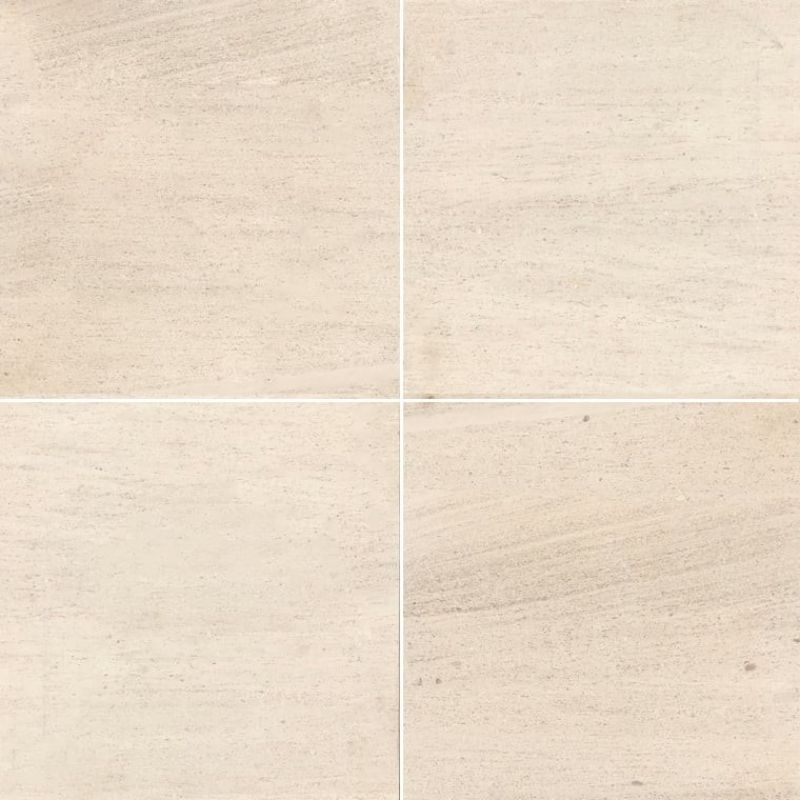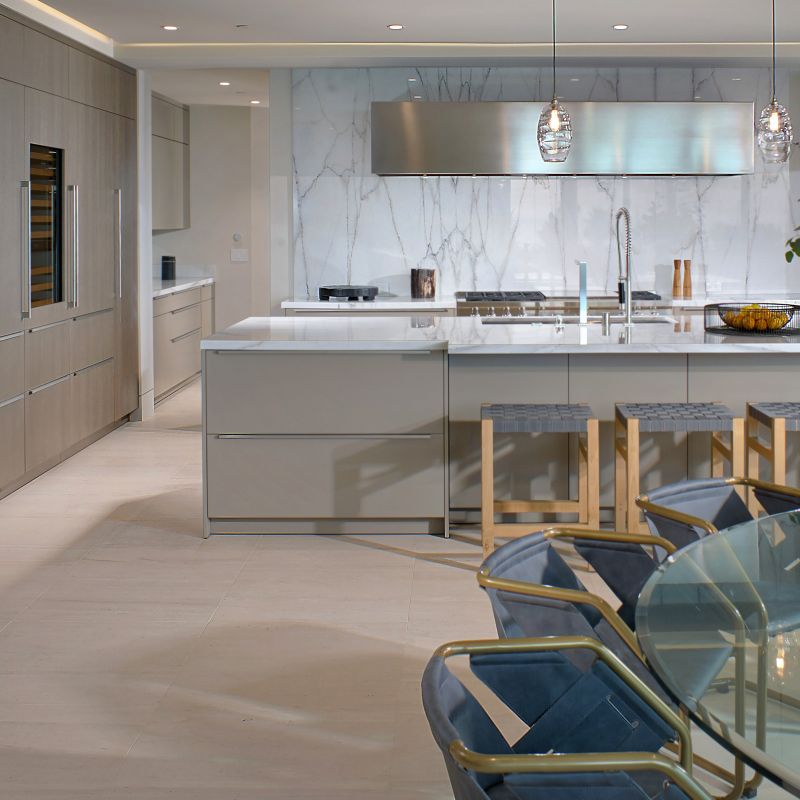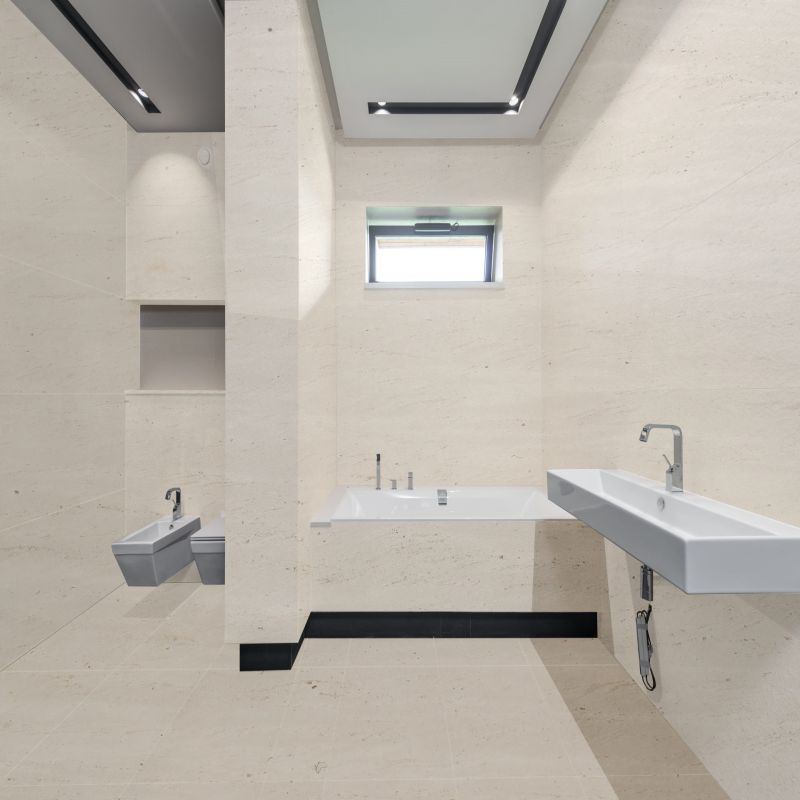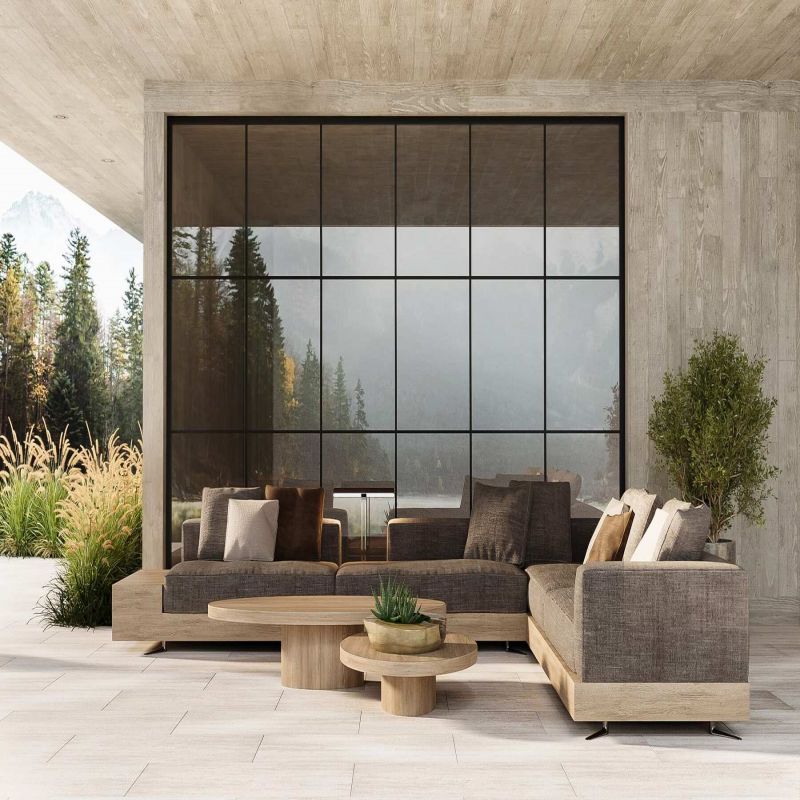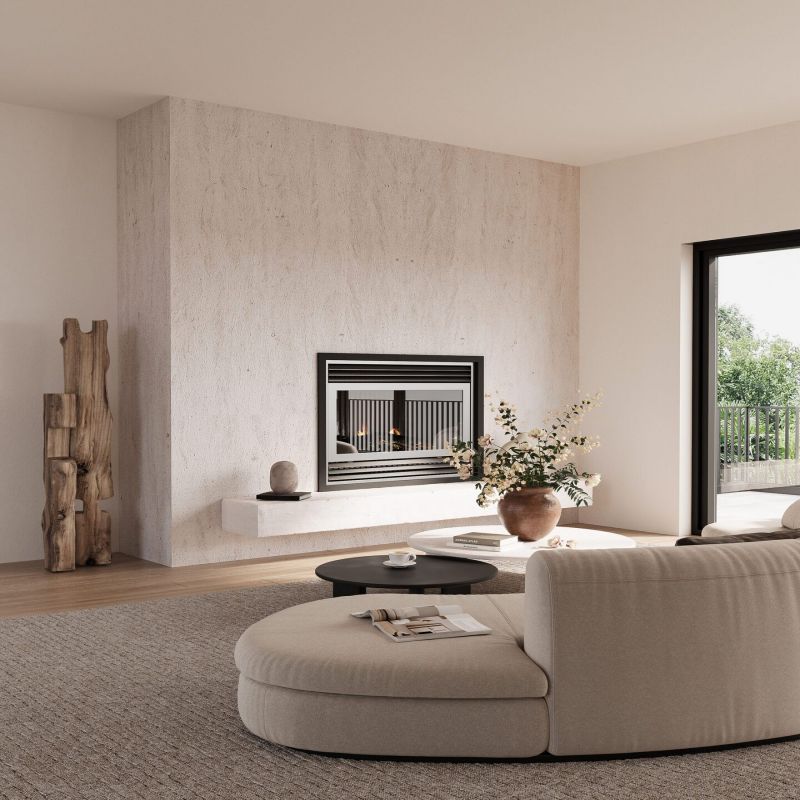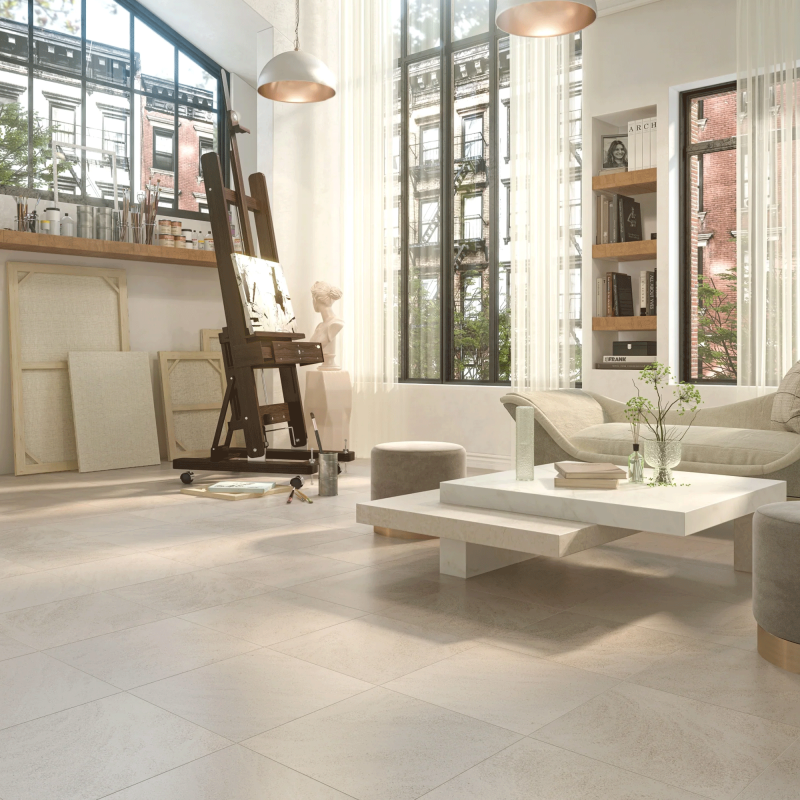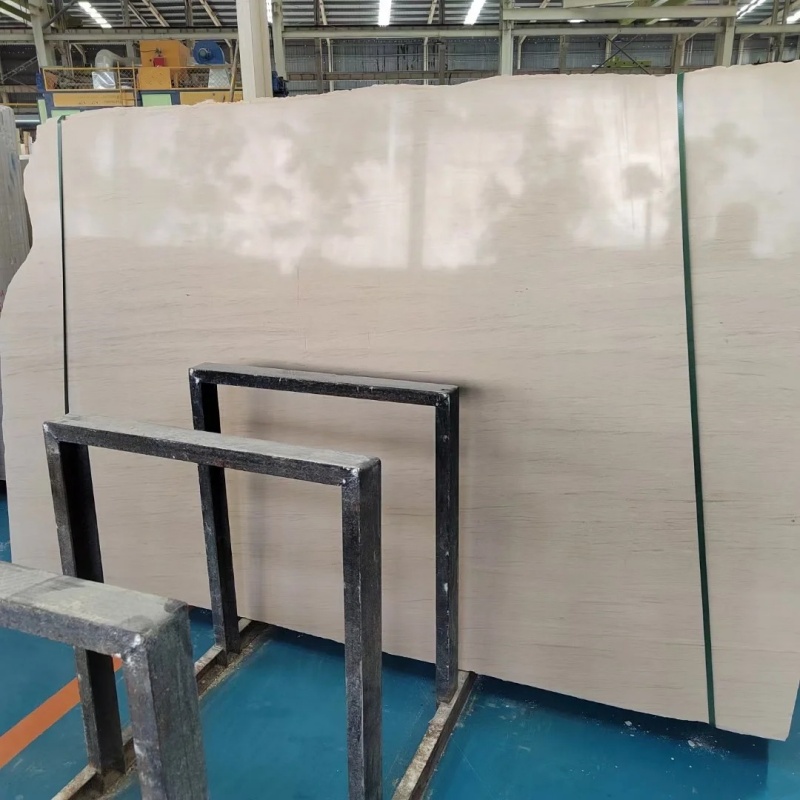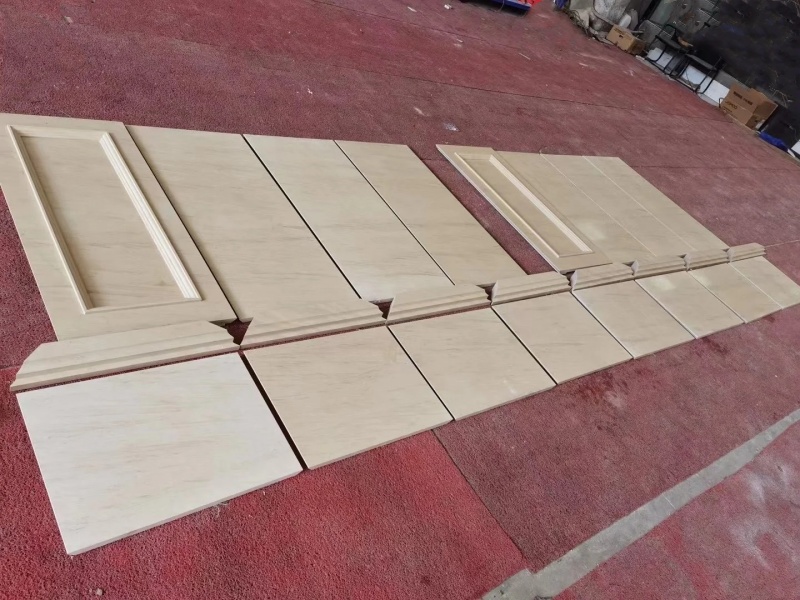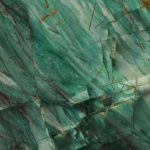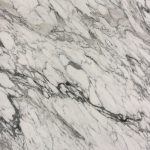Moca Cream Marble
Moca Cream Marble, also known as Moca Cream Limestone, is highly prized for its aesthetic versatility and durability. Here’s more detail about it:
1. Appearance:
- Color: Predominantly beige to light cream, Moca Cream exudes warmth and an inviting feel. The exact tone can range from light ivory to sandy beige.
- Veining: The stone is characterized by parallel veins that run horizontally, adding a linear flow to surfaces. The veins can range from subtle and fine to more prominent and wavy, depending on the block of stone. This veining is what often gives the stone a dynamic, textured look while maintaining its elegance.
- Texture: The surface can be polished to a high gloss, giving it a smooth, reflective finish, or honed for a matte, natural appearance. It may also be bush-hammered, sandblasted, or brushed for a rougher texture.
2. Types:
There are several varieties of Moca Cream Marble, differentiated by the intensity of veining, color tone, and overall texture. These include:
- Moca Cream Fine: A finer, more delicate veining with a lighter beige background.
- Moca Cream Medium Grain: Slightly more pronounced grains and veins.
- Moca Cream Classic: The most common variety, with moderate veining and a balanced cream color.
- Moca Cream Cross Cut: Veins appear in a non-linear, more scattered pattern.
3. Applications:
- Interior: Moca Cream Marble is ideal for indoor applications, such as:
- Flooring: Its light, neutral tones make it perfect for large areas like living rooms, hallways, and bathrooms.
- Wall Cladding: Both exterior and interior walls are commonly adorned with this marble, especially for creating feature walls or accent spaces.
- Countertops & Vanities: Its polished finish gives a sleek look to kitchen countertops, bathroom vanities, and tabletops.
- Fireplaces & Stairs: Adds an elegant touch to mantels, fireplace surrounds, and staircases.
- Exterior: Though softer than some stones, Moca Cream is also used in facades, columns, and decorative exterior elements due to its weather-resistant properties when properly treated.
4. Maintenance:
- Moca Cream Marble is relatively porous compared to harder stones like granite. Therefore, it requires regular sealing, especially in high-moisture areas like kitchens and bathrooms, to prevent staining or moisture absorption.
- Regular cleaning with non-acidic, pH-neutral cleaners is recommended to maintain its finish and appearance.
5. Quarries:
The stone is primarily quarried in the Alcanede region of Portugal, an area renowned for its limestone reserves. The Moca Cream quarries are some of the most well-known, and the stone exported worldwide is recognized for its quality and consistency.
6. Advantages:
- Aesthetic Appeal: Its soft beige tones and natural veining create a timeless, elegant look suitable for a range of design styles.
- Versatility: The stone complements both traditional and contemporary interiors, making it a popular choice for a wide variety of projects.
- Durability: Though softer than some stones, Moca Cream Marble is durable enough for most residential and commercial uses when properly maintained.
7. Disadvantages:
- Porosity: Being a limestone, it is more prone to scratching and staining than harder materials like granite or quartz.
- Cost: While not the most expensive marble, it is still priced as a premium material, and the cost can increase depending on the cut, finish, and type of installation.
In summary, Moca Cream Marble (Limestone) is a highly desirable material for those seeking a blend of natural beauty, elegance, and warmth in their design projects, whether for residential or commercial spaces. Its neutral tones and distinctive veining make it adaptable to many styles, but it does require proper care and maintenance.
How does Moca Cream Marble compare to other natural stones in terms of durability?
In terms of durability, Moca Cream Marble (Limestone) is generally considered softer and less dense than many other natural stones like granite or quartzite. Here’s how it compares to some common natural stones:
1. Moca Cream Marble vs. Granite:
- Durability: Granite is much harder and more durable than Moca Cream Marble. Granite is one of the hardest natural stones, making it highly resistant to scratching, chipping, and staining, while Moca Cream Marble, being a limestone, is more prone to surface damage and wear over time.
- Porosity: Granite is less porous than Moca Cream Marble, which means it is more resistant to staining and moisture absorption. Moca Cream needs more frequent sealing to protect against water and stains, particularly in areas like kitchens and bathrooms.
- Maintenance: Granite is relatively low-maintenance compared to Moca Cream Marble. While both stones benefit from regular sealing, Moca Cream requires more care to prevent etching and staining, especially from acidic substances.
2. Moca Cream Marble vs. Quartzite:
- Durability: Quartzite is a much harder stone than Moca Cream Marble, making it highly resistant to scratches and damage. It is one of the most durable natural stones available and is ideal for high-traffic areas.
- Porosity: Like granite, quartzite is less porous than Moca Cream Marble, offering better resistance to stains and moisture.
- Maintenance: Quartzite requires less maintenance than Moca Cream. Though sealing is still necessary, it doesn’t need to be done as frequently, and the risk of etching or staining is lower.
3. Moca Cream Marble vs. Marble (e.g., Carrara or Calacatta):
- Durability: Both Moca Cream and other marbles like Carrara or Calacatta are softer stones. However, Carrara and Calacatta marbles are typically denser and slightly harder than Moca Cream, meaning they may hold up better to wear and tear. Both types of stone are prone to scratching and etching, but Moca Cream may be more vulnerable.
- Porosity: All marble types, including Moca Cream, are relatively porous and susceptible to staining. Like other marbles, Moca Cream requires regular sealing and careful cleaning to prevent damage from acidic or staining substances.
- Maintenance: The maintenance requirements for Moca Cream Marble and other marbles are quite similar, though the lighter color of Moca Cream may make stains and wear more visible, necessitating more attention.
4. Moca Cream Marble vs. Travertine:
- Durability: Travertine, another type of limestone, has a similar softness to Moca Cream Marble. Both are prone to scratching and are more delicate than granite or quartzite. However, travertine is often sold in a more rugged, rustic form with filled holes, making it a bit more forgiving in terms of visible wear.
- Porosity: Both Moca Cream and travertine are highly porous stones and require regular sealing to prevent water absorption and staining.
- Maintenance: Both stones require a fair amount of maintenance. Travertine can develop pits and holes over time, which may require filling. Moca Cream Marble may need more frequent cleaning and sealing, but it offers a smoother, more refined look.
5. Moca Cream Marble vs. Slate:
- Durability: Slate is much harder and more durable than Moca Cream Marble. It is resistant to scratching, chipping, and cracking, making it a better choice for high-traffic areas.
- Porosity: Slate is less porous than Moca Cream Marble and is not as prone to staining, though it may still benefit from sealing.
- Maintenance: Slate is much easier to maintain than Moca Cream Marble. It requires less frequent sealing and is generally more resistant to damage.
6. Moca Cream Marble vs. Limestone (e.g., Jura Beige):
- Durability: Both Moca Cream and other limestones like Jura Beige share similar properties in terms of hardness and durability. However, some limestones, such as Jura, are denser and more durable than Moca Cream, making them more suitable for heavy-use applications.
- Porosity: All limestones, including Moca Cream, are relatively porous and require sealing to protect against moisture and stains. Jura Beige, being denser, may be slightly less porous.
- Maintenance: Both types of limestone require regular sealing and maintenance, though denser limestones may hold up better in high-traffic areas or exterior environments.
Summary of Durability Comparison:
- Granite & Quartzite: Far more durable, harder, and less porous, making them ideal for heavy-use areas and low-maintenance applications.
- Other Marbles (Carrara, Calacatta): Similar maintenance requirements, though denser marbles may perform slightly better in terms of wear.
- Travertine: Similar in softness and porosity, though often has a more rustic finish that can hide wear better than Moca Cream’s smooth surface.
- Slate: Much more durable and lower maintenance than Moca Cream.
- Other Limestones (Jura Beige): Comparable in softness, though some denser limestones may outperform Moca Cream in durability.
In conclusion, Moca Cream Marble is best suited for low- to medium-traffic areas, where aesthetic value is prioritized over extreme durability. For high-traffic, outdoor, or heavy-use areas, harder stones like granite, quartzite, or slate are typically more suitable.
What’s the Application of Moca Cream Marble ?
Moca Cream Marble a range of high-end interior projects since its beauty and unusual tint are widely appreciated.
- Moca Cream Marble countertop :Moca Cream Marble is often used to create stunning kitchen countertops and bathroom vanity tops. Its striking beige color and intricate veining add elegance and sophistication to these spaces.
2.Wall Cladding: As a wall covering,Moca Cream Marble can create a focal point in any room. It is used in both residential and commercial settings to enhance the visual appeal of walls.
3.Flooring: While it is less commonly used for flooring compared to harder stones like granite ,Moca Cream Marble still be used in areas with light foot traffic, such as bathrooms, entryways, and other interior spaces.
4.Feature Walls: The dramatic veining and color variations of Moca Cream Marble make it ideal for creating accent walls or feature walls in living rooms, dining rooms, or even hotel lobbies.
5.Decorative Items: Smaller pieces of Moca Cream Marble, such as tabletops, fireplace surrounds, and decorative objects, can be used to add a touch of luxury and sophistication to interior design.
6.Bathroom Applications: Besides vanity tops,Moca Cream Marble can be used for shower walls, bathtub surrounds, and other bathroom surfaces to create a spa-like atmosphere.
7.Furniture: Custom furniture items like side tables, dining tables, and coffee tables. These works of art that are also useful elevate any room. Each furniture piece is distinctive and draws attention because of the distinctive patterns and colours of this Moca Cream Marble
8.Art Installations: Designers and artists frequently work with Moca Cream Marble to produce one-of-a-kind art installations. In galleries, public areas, and private collections, artistic works are made stand out by the depth and personality that the natural beauty of the stone provides.
What are the unique features of Moca Cream Marble that make it appealing for interior design?
Moca Cream Marble is highly appealing for interior design due to its unique combination of aesthetic and functional characteristics. Here are some of the key features that make it a popular choice:
1. Elegant, Neutral Color Palette:
- Soft Beige Tones: Moca Cream Marble has a warm, neutral beige color that ranges from light cream to sandy tones. This natural, soothing palette allows it to blend seamlessly into various interior design styles, from modern minimalism to classic or traditional decor.
- Versatility in Design: Its neutral shades make it an excellent backdrop for a wide range of color schemes. Whether paired with bold, vibrant accents or muted, earthy tones, Moca Cream creates a sophisticated, cohesive look.
2. Distinctive Veining Patterns:
- Linear Veining: One of Moca Cream’s signature characteristics is its parallel, horizontal veining. This veining varies in thickness and intensity, providing designers with options for creating visual movement and texture on surfaces like walls, floors, and countertops.
- Subtle or Bold Aesthetic: Depending on the selection, Moca Cream Marble can offer anything from subtle, fine veins to more dramatic, bold lines. This flexibility allows designers to achieve either a soft, understated look or a more defined, eye-catching design.
3. Texture Options:
- Polished Finish: When polished, Moca Cream Marble has a smooth, reflective surface that exudes luxury and elegance. This finish enhances the stone’s natural beauty by bringing out its veining and giving it a sleek, high-end appearance, perfect for modern or formal spaces.
- Honed Finish: A honed, matte finish provides a more subtle, natural look with less shine, making it ideal for creating a relaxed, organic aesthetic. This finish is perfect for spaces where a more understated or contemporary design is desired.
- Other Finishes: Moca Cream can also be textured through bush-hammering, brushing, or sandblasting to create a rougher, more rustic finish. These options allow it to be tailored for diverse design preferences, whether it’s for a rustic, industrial, or outdoor setting.
4. Visual Continuity:
- Large, Uniform Slabs: Moca Cream Marble is often used in large-format slabs, allowing for a seamless look across expansive surfaces. This feature is especially valuable for flooring, wall cladding, or large kitchen islands, where continuity and visual flow are desired.
- Horizontal Orientation: The stone’s linear veining makes it particularly effective for creating a sense of width or elongation in a space. For example, when used in wall cladding, the horizontal veins can make a room appear more spacious.
5. Timeless Elegance:
- Classic Appeal: The warm beige tones and natural veining of Moca Cream Marble evoke a timeless elegance that never goes out of style. Its sophisticated yet understated appearance has made it a favorite for high-end interiors, including luxury homes, hotels, and commercial spaces.
- Adaptability to Different Design Trends: While Moca Cream Marble is timeless, its neutral palette and clean lines also make it adaptable to current design trends, whether it’s a minimalist, Scandinavian-inspired interior or a more ornate, traditional style.
6. Versatility of Application:
- Multiple Uses: Moca Cream Marble is highly versatile and can be used in a wide range of applications. It is commonly used for:
- Flooring: Its smooth texture and neutral color make it ideal for large floor areas, providing a uniform and cohesive look.
- Wall Cladding: It adds a luxurious touch to interior walls, creating focal points and accent walls in living rooms, bathrooms, or entryways.
- Fireplaces: Moca Cream’s warmth and elegance make it a great choice for fireplace surrounds, adding both beauty and subtlety to a room’s design.
- Staircases: The stone’s linear veining enhances the visual length of staircases, adding to its sophisticated appeal.
- Countertops: In kitchens and bathrooms, Moca Cream Marble gives countertops a refined, upscale look.
- Interior and Exterior Uses: Though primarily used indoors, Moca Cream can also be used in certain exterior applications, such as facades, columns, or terraces, provided it is properly sealed and maintained.
7. Natural, Organic Aesthetic:
- Earthy, Calming Feel: The soft tones and natural patterns of Moca Cream Marble create a calm, grounded atmosphere, making it perfect for spaces where relaxation is a priority, such as bathrooms, bedrooms, and living areas.
- Biophilic Design: As part of the growing trend toward biophilic design, which integrates nature into indoor spaces, Moca Cream Marble’s natural, organic qualities provide a connection to the earth. This enhances the overall feeling of warmth and wellness in a home or commercial space.
8. Luxurious Appeal without Being Overpowering:
- Moca Cream Marble adds a sense of luxury without the overwhelming visual impact that darker or more colorful stones might bring. Its subtle elegance makes it suitable for creating sophisticated spaces without making the design too ornate or flashy.
9. Customization Possibilities:
- Tailored for Specific Projects: Moca Cream Marble can be cut and finished in a variety of ways, allowing designers to customize it to fit the specific needs of a project. For example, slabs can be selected for more intense veining for bold statements, or finer, more consistent patterns for a calm, minimalist approach.
10. Natural Stone Durability:
- Long-lasting: While not as hard as granite, Moca Cream Marble is still durable and, when properly maintained, can last for many years in interior applications. This makes it a worthwhile investment in terms of both aesthetics and functionality.
- Timeless Investment: Given its classic appeal, Moca Cream Marble is often considered a long-term investment in a property’s value. Its natural elegance enhances the perceived quality and sophistication of the space.
Conclusion:
The unique combination of soft, neutral tones, natural veining, and texture options, along with its versatility in application, makes Moca Cream Marble highly appealing for interior design. Whether used in residential or commercial projects, it offers timeless elegance, adaptability, and a calm, organic aesthetic that elevates any space. Its ability to create visual continuity and seamless surfaces makes it particularly popular for large-scale installations, such as flooring, wall cladding, and countertops.
Factors affecting Moca Cream Marble ?
Several factors can affect the performance, appearance, and longevity of Moca Cream Marble. Understanding these factors is important for proper installation, maintenance, and ensuring that it meets the design and functional needs of a space. Here are the key factors:
1. Porosity and Absorption:
- High Porosity: Moca Cream Marble is a type of limestone, which is naturally more porous than harder stones like granite or quartzite. This means it can absorb liquids, which may lead to staining, especially in areas like kitchens, bathrooms, or outdoor spaces.
- Sealing: Regular sealing is essential to reduce its porosity and protect the surface from moisture, spills, and staining. The type of sealant used and how frequently it is applied can significantly affect the stone’s durability and appearance.
2. Surface Sensitivity to Acids:
- Etching from Acidic Substances: Like other marbles, Moca Cream is sensitive to acidic substances such as lemon juice, vinegar, coffee, wine, and some cleaning products. These acids can cause “etching,” which appears as dull spots or marks on the surface. The lighter color of Moca Cream Marble makes etching more noticeable.
- Preventive Measures: Using coasters, placemats, and mild cleaning agents can help minimize etching. Cleaning spills immediately and avoiding harsh chemicals are crucial for maintaining the stone’s appearance.
3. Scratching and Abrasion:
- Softness: As a limestone, Moca Cream Marble is softer than harder stones like granite or quartz. This makes it more prone to scratching and wear, especially in high-traffic areas or spaces where heavy objects are frequently moved (e.g., kitchen countertops, living room floors).
- Polished vs. Honed Finish: Polished surfaces tend to show scratches more easily than honed surfaces. While a polished finish enhances the stone’s elegance, a honed or matte finish may be better suited to areas with high foot traffic or frequent use.
4. Moisture and Humidity:
- Water Sensitivity: In areas with high moisture or humidity, such as bathrooms or kitchens, Moca Cream Marble can absorb water, leading to potential discoloration, mildew, or mold if not properly sealed and maintained.
- Use in Wet Areas: While Moca Cream can be used in bathrooms and kitchens, proper sealing and ventilation are necessary to prevent water-related issues. In shower areas or near sinks, sealing should be done more frequently to protect the stone from water infiltration.
5. UV Exposure and Fading:
- Sunlight Sensitivity: Prolonged exposure to direct sunlight can cause Moca Cream Marble to fade or change color over time. This is particularly important for exterior applications or rooms with large windows and significant natural light.
- UV Protection: In areas with high sunlight exposure, using UV-resistant sealers or window treatments (e.g., blinds, UV-protective glass) can help minimize fading and protect the marble’s original color.
6. Temperature Changes:
- Thermal Sensitivity: Like many natural stones, Moca Cream Marble can be sensitive to rapid temperature changes. Extreme fluctuations, such as placing hot cookware directly on a marble countertop, can cause thermal shock, leading to cracking or discoloration.
- Heat Protection: To prevent thermal damage, trivets or heat-resistant pads should be used under hot pots, pans, and appliances on countertops. In outdoor applications, choosing a lighter-colored marble like Moca Cream can help reduce heat absorption compared to darker stones.
7. Traffic and Usage:
- Wear in High-Traffic Areas: Moca Cream Marble is not as hard as granite or quartz, so it can show wear more easily in high-traffic areas like hallways, kitchens, or entryways. Over time, it may develop a “patina” or dull finish due to repeated use and abrasion.
- Surface Treatments: To protect the marble from excessive wear, regular maintenance such as resealing, polishing, or refinishing may be necessary. For high-traffic areas, choosing a honed finish may help minimize visible signs of wear.
8. Installation Quality:
- Proper Installation: The installation process is critical for the longevity and appearance of Moca Cream Marble. Incorrect installation (e.g., improper subfloor preparation, uneven sealing, or inadequate mortar) can result in cracks, staining, or tile displacement over time.
- Grout and Adhesives: The type of grout and adhesive used during installation can also impact the marble. Certain adhesives can discolor the marble, so it’s important to use materials specifically designed for natural stone.
9. Maintenance Practices:
- Cleaning Routine: Regular, proper cleaning is essential to maintaining the appearance of Moca Cream Marble. Harsh chemicals or abrasive cleaners can damage the stone, dulling the finish or causing scratches. Instead, pH-neutral, stone-safe cleaners should be used to prevent long-term damage.
- Frequency of Sealing: The frequency with which the marble is sealed depends on the level of use, the location of the marble, and the environment. A marble surface that sees daily use may require sealing every 6–12 months, while areas with less frequent use may only need to be sealed once a year or less.
10. Environmental Factors:
- Outdoor Use: When used outdoors, Moca Cream Marble is exposed to the elements, including rain, sunlight, and pollution. These factors can affect its appearance and durability over time. Proper treatment with water-resistant and UV-protective sealants is necessary to maintain its condition in exterior applications.
- Frost Damage: In colder climates, water can penetrate the stone’s pores and freeze, causing cracks due to expansion. For exterior installations in such climates, additional precautions like using water-repellent sealers are important to prevent frost damage.
11. Stone Variation:
- Natural Variations: As a natural material, Moca Cream Marble may have variations in color, veining, and texture from slab to slab. This is part of its charm but can be a consideration when matching stone for large projects. When designing with Moca Cream, it’s important to select slabs from the same batch to ensure consistency across the surface.
- Batch Differences: Different batches of Moca Cream Marble may show differences in tone or pattern intensity, so it’s crucial to source enough material for a project from the same quarry batch to avoid inconsistencies.
12. Chemical Sensitivity:
- Reactivity with Cleaners: Many common household cleaners can be too harsh for Moca Cream Marble, particularly those containing bleach, ammonia, or acidic compounds. These can damage the finish, cause etching, or discolor the stone.
- Using Marble-Safe Products: Only cleaners formulated for use on natural stone should be applied to Moca Cream Marble. Stone-safe, pH-neutral cleaners will prevent chemical damage and maintain the marble’s surface integrity.
Conclusion:
Moca Cream Marble is a beautiful and elegant natural stone, but its softness, porosity, and sensitivity to acids and environmental factors make it more vulnerable to wear and damage than harder stones like granite or quartz. Proper installation, regular sealing, and careful maintenance are essential to preserving its appearance and longevity. Despite these factors, its timeless aesthetic appeal, warmth, and versatility make it a popular choice for interior and some exterior applications.
Why Opt For Xiamen Funshine Stone?
1.Our design consultation service at Funshine Stone gives our customers peace of mind, high-quality stone, and professional guidance. Our expertise lies in natural stone design tiles, and we offer comprehensive “top to bottom” consulting to realize your idea.
2.With a combined 30 years of project expertise, we have worked on a vast array of projects and established enduring relationships with numerous people.
3.With a huge assortment of natural and engineered stones, including marble, granite, bluestone, basalt, travertine, terrazzo, quartz, and more, Funshine Stone is pleased to provide one of the largest selections available. It is clear that our use of the best stone available is superior.







